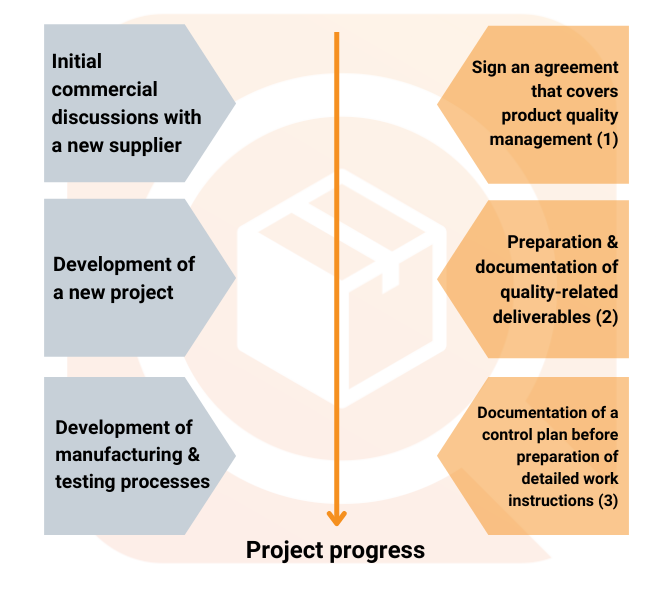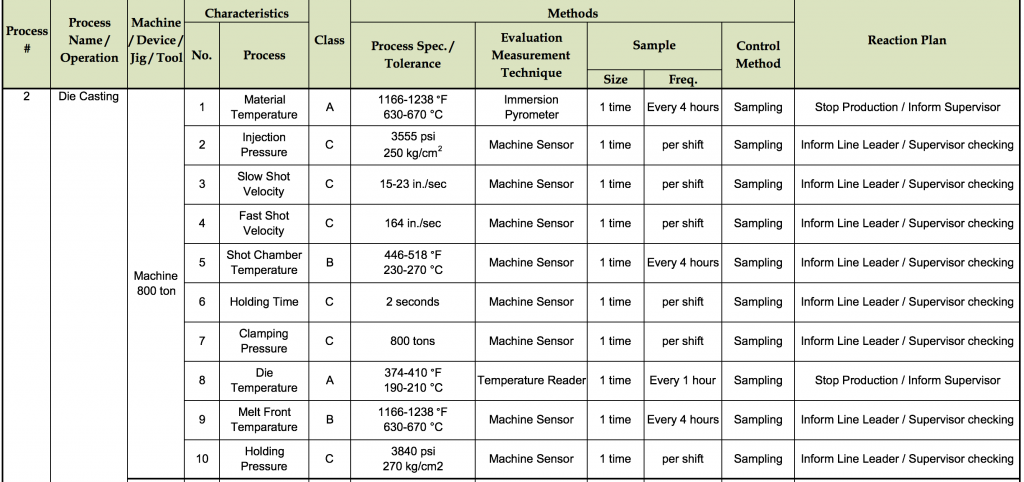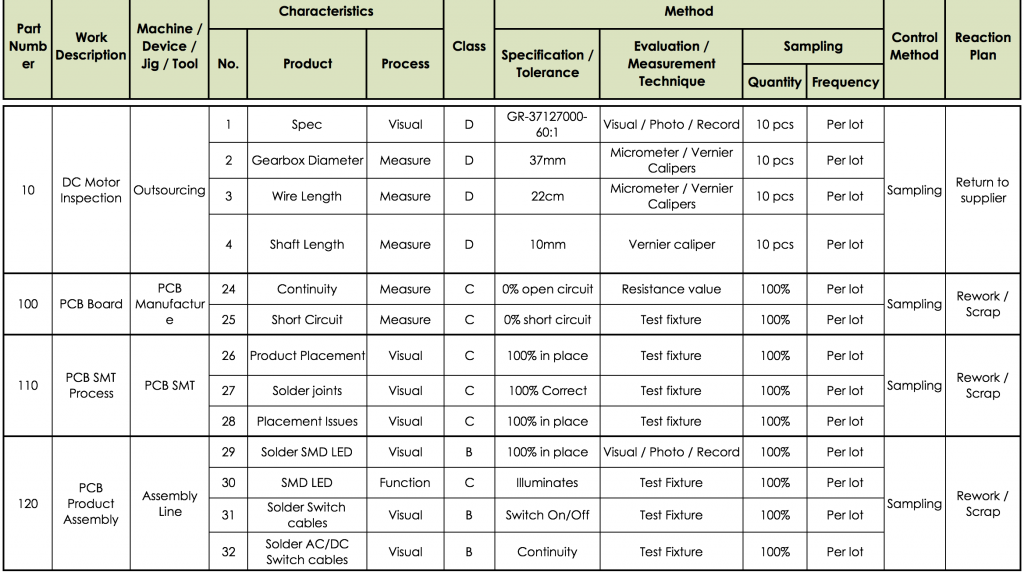Depending on the context, “quality control plan” means different things.
Let’s look at the three types of quality control plans:
- The product quality control plan to include in a contract with a Chinese supplier
- The QC plan for a new product being brought to market
- The process control plan that decomposes production in each process step (often called control plan)
They come up at different stages in the life cycle of a product:

First let’s look at the plan that becomes part of your contract with a supplier.
1. The product quality control plan to include in a contract with a Chinese supplier
Defining a basic quality control plan with every new supplier is one of those things that take little time but that can save lots of time and money. It can be standardized and sent to every supplier with only minor adaptations. Buyers are advised to talk about it with a manager working for the supplier company, and to get it signed/chopped.
By the way, a quality control plan is a standard part of contracts drafted by specialized lawyers. The product specifications are usually an appendix to such contracts.
So, what to include in a quality control plan?
Of course, it depends on each buyer’s needs. I wrote a short (and fictitious) plan below, for inspiration.
Timing of inspections
BUYER reserves the right to send one of his employees/representatives (including an outside inspection agency) in the factory to inspect production at any time, with reasonable advance notice.
Communication of status of production
SUPPLIER should send an email to BUYER 3 days before it receives the main materials/components, and should send a confirmation email on the day they arrive in the factory’s warehouse.
SUPPLIER should send an email to BUYER 3 days before the factory starts assembling its order, and should send a confirmation email on the same day it happens.
SUPPLIER should send an email to BUYER 3 days before the first finished products are out of the lines (i.e. fully produced), and should send a confirmation email on the same day it happens.
SUPPLIER should send an email to BUYER 3 days before 100% of the shipment quantity is finished and 80% is fully packed (i.e. ready to ship), and should send a confirmation email on the same day it happens.
SUPPLIER should send an email to BUYER every time some samples are sent to a laboratory for testing.
[This may make sense for you, in case the supplier only does assembly. You may have to change the wording based on the processes they do in-house, and also based on the amount of cooperation & project management you expect.]
Description of quality control activities
BUYER reserves the right to perform the following quality control activities, and any other activity not described below.
Product inspections: random inspections of products, conducted based on the ISO2859-1 standard (single-stage, normal severity, level to be determined by BUYER). Acceptance quality limit (AQL) is 0% for critical defects, 1.5% for major defects, 4.0% for minor defects.
Lab tests: SUPPLIER will have to send 2 samples to ABC laboratory for tests as decided by BUYER, in order to respect the consumer safety law of the importing country/ies. These samples must be extracted from bulk production. BUYER may, or may not, ask one of his representatives to pick these samples.
[Obviously, re-write this based on your requirements. And the AQL limits may be product-specific, which means they should be in each product’s specification sheet.]
Testing & measuring equipment that must be available in the factory
For your own quality control activities, and for our inspection activities, the following pieces of equipment must be present in the factory:
-
- Weighing scale for export cartons
- Weighing scale for the products
- Hi-pot tester
[Customize this list as you see fit. List the most important testing & measuring equipment for your products in general. More product-specific information can be listed in your product specification sheet.]
What to do in case of failure?
If a product inspection or a laboratory test is failed, SUPPLIER will get in contact with BUYER within 24 hours with a detailed explanation. If a shipment is delayed because of unacceptable quality, SUPPLIER will bear all consequences for this delay.
If a product inspection is refused, BUYER has the right to ask for a re-inspection, the cost of which will be deducted from the next payment to SUPPLIER. And so on until the inspection is accepted by BUYER.
If more than 1% of products are found defective and/or not conform to product specifications, SUPPLIER will check the whole quantity and will sort them out of bulk quantity. If rework/repair is impossible, SUPPLIER should let BUYER know immediately about it.
If the inspection is failed (and/or the findings in the report are refused by BUYER) twice in a row, BUYER reserves the right to ask SUPPLIER to pay for a third-party inspection firm (appointed by BUYER in written), which will do a 100% check on the shipment.
If a lab test is failed, SUPPLIER will have to pay for additional tests from the same laboratory.
[You might want to re-write this based on your needs. See related articles about corrective action plans and about the alternatives when an inspection is failed.
What inspections and lab tests do NOT represent
Product inspections and lab tests are only tools used by BUYER to take a decision. Putting pressure on an inspector is useless and is forbidden. Trying to give money/favors to an inspector is forbidden by law and will end all business relationships between BUYER and SUPPLIER.
Even if all inspections and tests are passed, SUPPLIER should wait for BUYER’s agreement for shipment.
Even if all inspections and tests are passed, they do not relieve SUPPLIER from its contractual liabilities or prejudice BUYER’s right for compensation for any apparent and/or hidden defects not detected by the inspection(s) and/or the test(s).
Now let’s look at the other type of control plan.
2. The process control plan that decomposes production in each process step
Writing this document forces the manufacturer to do two things:
- Identify each process step, and indicate whether it is critical (i.e. likely to cause serious quality issues if improperly handled) or not;
- Define the process controls: what to check, how often, using what methods, and what to do if issues are found.
Here is an example of a process control plan:
In this example, you can see what to check regularly on a die casting machine. (Note that the mould and the materials also need to be checked regularly — it’s not only about the machine.)
It is mostly used by the North American and European auto industry, but it is VERY useful for any production. The more immature and/or complex the process, the more useful. We seldom see it for a very simple production (e.g. kitting together 2 components by hand.)
Ideally, this is prepared by the manufacturer. But sometimes the buyer has to send their own engineers or bring in external resources. (We routinely prepare quality control plans together with the work instructions for production operators, in case the manufacturer is not motivated/capable of preparing those documents.)
Note that the control plan often includes a mix of process controls and product controls.
Here is an example of product control:
What types of product controls are often included?
- Incoming component checks
- Semi-finished product checks
- Finished product checks
3. The QC deliverables for a new product
Here is what the manufacturer will need to know, before going into production. If you start production without some of that information properly documented, you face severe risks.
(Note, this list is well suited to electro-mechanical products.)
1. Quality, Reliability, Compliance
- Is there a specific and documented quality standard?
- Is there a final approved prototype (or ‘golden sample’)?
- Are testing jigs/fixtures needed? Are they already made and signed off?
- What environment will the product operate in, and how long should it keep working? Was reliability testing already conducted?
- What countries will the product be sold in? Any applicable certifications?
2. Components (including packing materials)
- Is a production BOM (bill of materials) complete?
- Any environmentally friendly requirements? (e.g. recycled materials, no plastic in packaging, …)
3. Manufacturing
- What will the production volumes be?
- Is any tooling (e.g. injection molds) needed? Is it already made and signed off?
- Do you have instructions (or a video) on the assembly methods?
- Is this the first time this product is manufactured? Or is it already a mature product (made several times in the past)? Is there a list of risks and known issues?
Conclusion
So, what should you focus on, if you want to ensure your production quality is under control? What is the minimum you need to work on?
- If you buy standard (off-the-shelf) goods that are made in China or other Asian countries, I would advise to first spend time on defining your requirements concerning the finished products. That’s the fundamental document. Make sure you approve pre-production samples. And engage a QC inspection agency.
- If you are developing a new product, there is so much more that you need to work on. Make sure to read section 3 (above) of this article, as it will give you a basic plan.
Extra reading >> If you’d like to learn even more about QC, read our detailed Quality Control basic concepts post here.




Hi Renaud,
Great advice on the OEM agreement which can be use to protect client’s interest against the manufacturer. Would you have a referral to draft one for me should I need such agreement in both Chinese and English?
Thanks in advance,
Jack
Hi Jack,
Thanks for the positive comment!
If you need to draft an OEM agreement in Chinese, with an English translation for your reference, you can contact Dan Harris at http://www.harrismoure.com/our-people.html. His firm has lawyers in China, and they have experience with OEM agreements.
Good luck with that, and don’t hesitate to get back in touch with me.
Renaud
Thanks Renaud!
Best wishes
Thanks For Shring Comment. Your Site Really Cool And Nice. Your Articles Is Good.
Your site is phenomenal and has helped me immensely. It is easy to understand and interesting compared to others. Que. on the product inspections….do you recommend that it always be done by a 3rd party? What are your thoughts on having the actual factory inspect the goods and if the inspection is rejected twice (initially and after a re-work) THEN a 3rd party be brought in for 100% inspection? Thanks!
Thanks Ginger.
Unfortunately, if the factory’s own internal quality control team finds problems, in 99% of cases they will not tell their customer about it.
You should either send your own team, or use a 3rd party inspection firm.
why we manage in chaintype in quality or our channel more
plz show me plan of qa/qc
how do you know if a supplier in china is reputable?
Please see this article: https://qualityinspection.org/background-checks-china